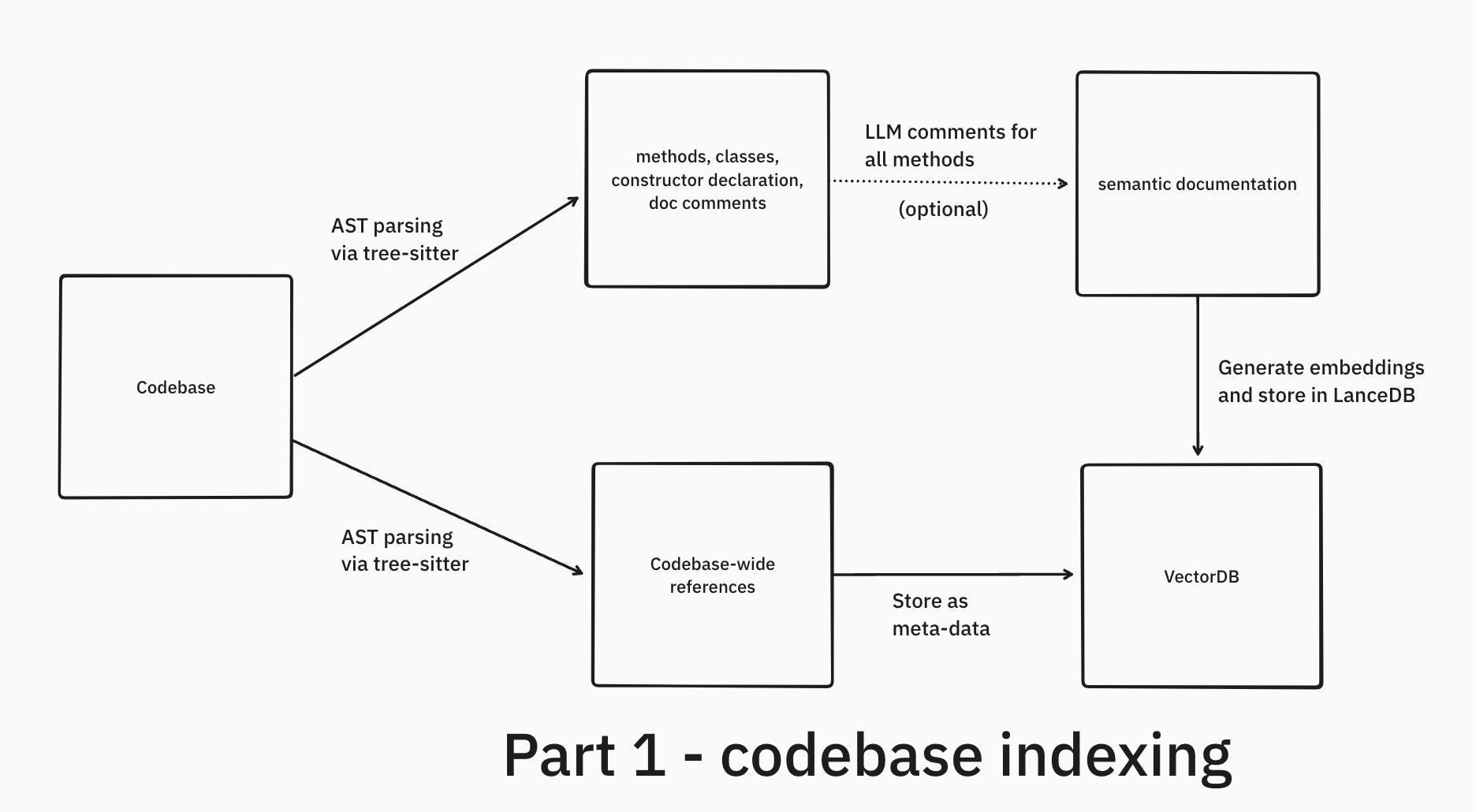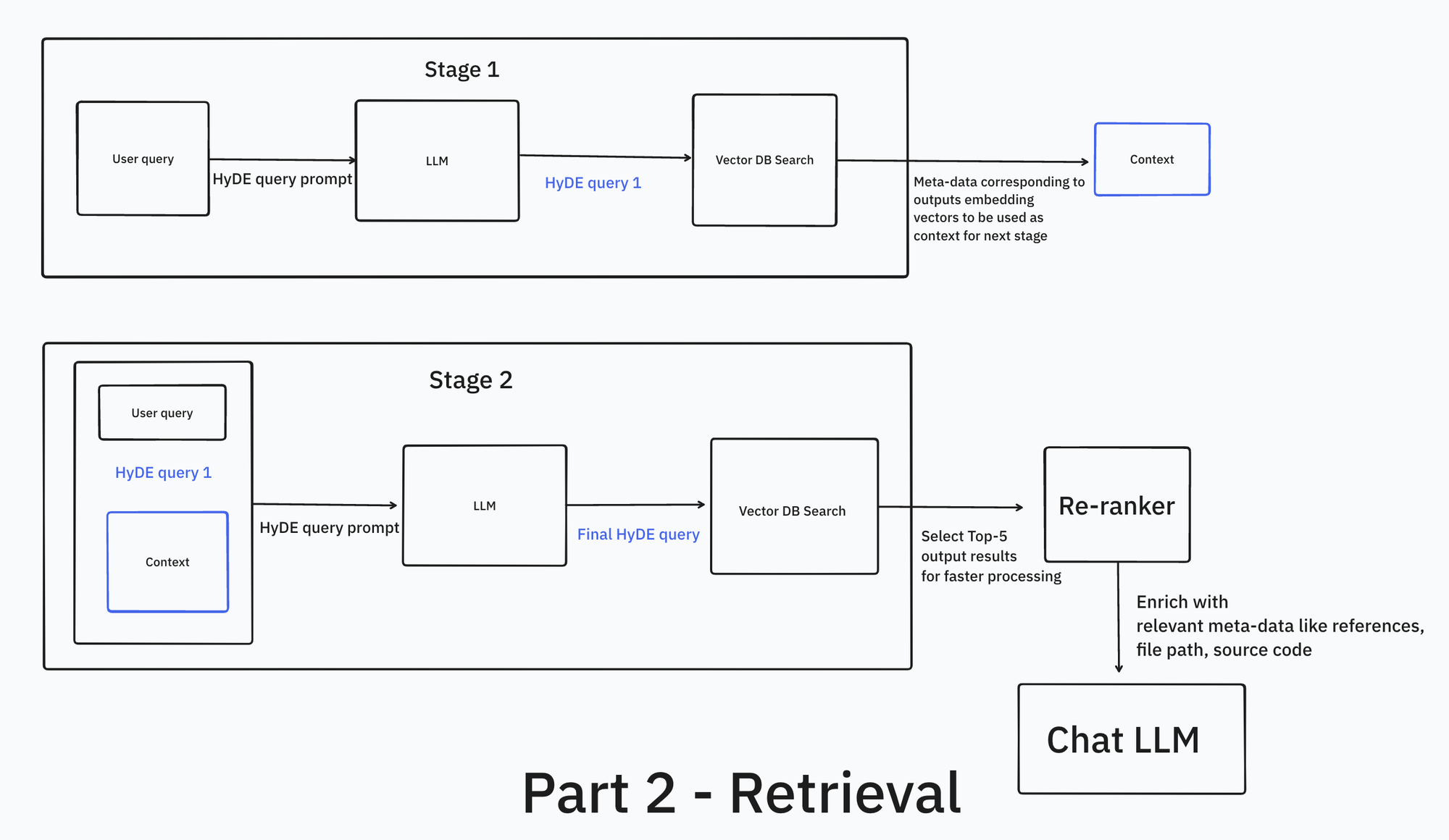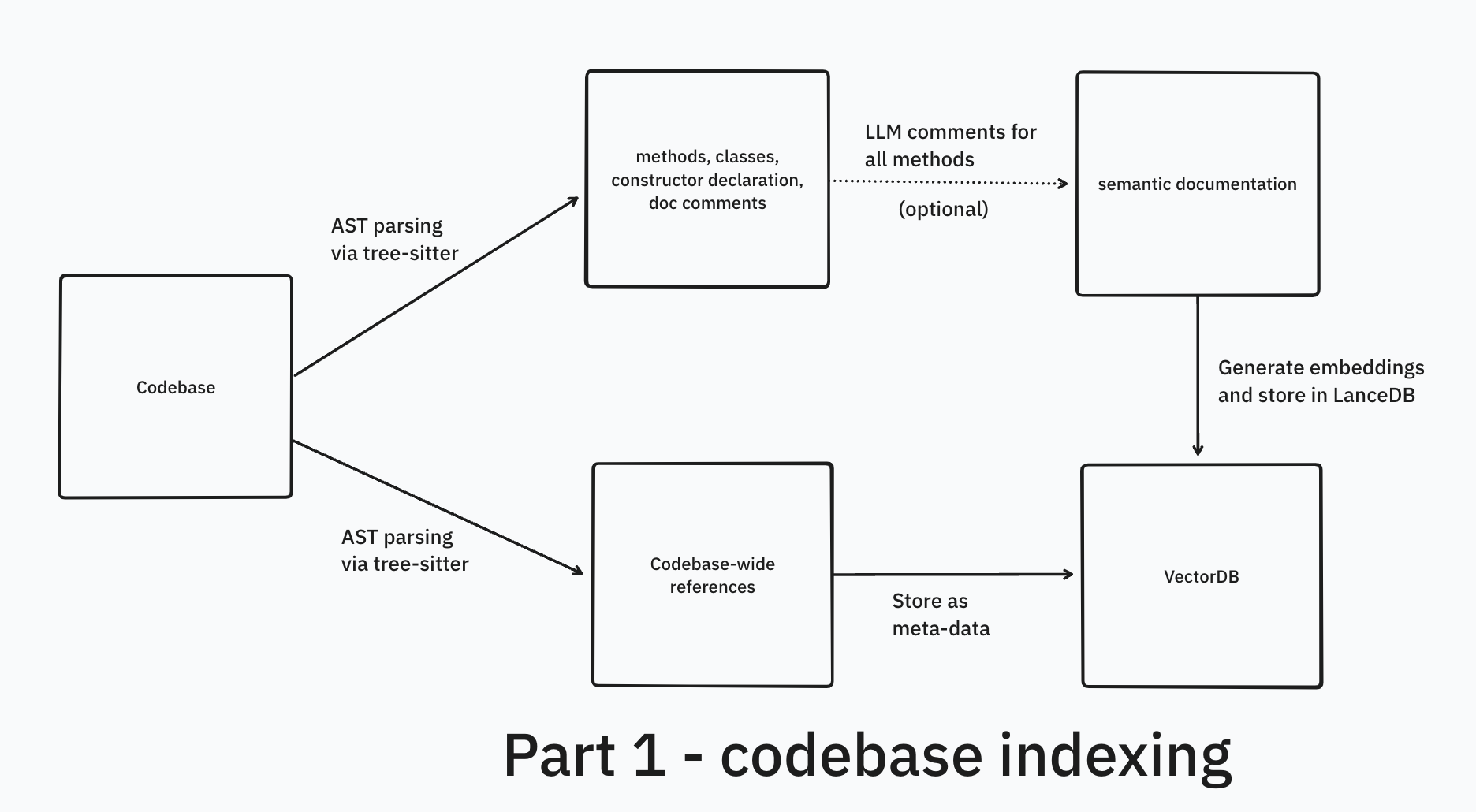The project will look something like this:
Introduction
If you have used the Cursor code editor's @codebase feature, you're probably familiar with how helpful it can be for understanding codebases. Whether you need to find relevant files, trace execution flows, or understand how classes and methods are used, @codebase gathers the necessary context to help.
I worked on a project called CodeQA that does the above.Just like Cursor @codebase feature, CodeQA is able to answer your code-base wide queries with relevant snippets, file names and references. It supports Java, Python, Rust and Javascript and can be extended to other languages easily.
Implementation can be found here - CodeQA Github Link
A glimpse of the end result - CodeQA Demo Link
There are two crucial parts to this - codebase indexing (Part 1) and the retrieval pipeline (Part 2). This post is all about codebase indexing with the help of tree-sitter and embedding search with help of LanceDB.


What to expect
This article focuses on concepts and the approaches one can take rather than specific code details (except towards the end).
Key topics include why in-context learning isn't the best approach, naive semantic code search, types of chunking, and syntax-level chunking using the tree-sitter library.
Knowledge assumed - Python programming, word embeddings
Terminology - query means questions, LLM = Large Language Model, natural language = languages we speak like English
In next few sections, let’s try to break down the problem into sub-problems and see what we can do to make things work.
Problem Statement
The goal is to build an application that will help the user to understand their codebase and generate accurate code by providing the following capabilities:
- Answer natural language questions about a codebase with accurate, relevant information when user mentions the keyword "@codebase"
- Provide contextual code snippets and analyze code usage patterns, including:
- How specific classes and methods are used
- Details about class constructors and implementations
- Track and utilize code references to:
- Identify where code elements are used across the codebase
- Provide source references for all answers
- Leverage gathered context to assist with code generation and suggestions
Questions can range from simple (single-hop) to complex (multi-hop). Single-hop questions can be answered using information from a single source, while multi-hop questions require the LLM to gather and synthesize information from multiple sources to provide a complete answer.
Examples:
- "What is this git repository about?"
- "How does a particular method work?" → where you may not mention the exact name of method
- "Which methods do xyz things?" → it is supposed to identify the relevant method/class names from your query
- They can be more complex, e.g. "What is the connection between
EncoderClassandDecoderClass?" → The system is supposed to answer by gathering context from multiple sources (multi-hop question answering)
Now that the problem statement is clear, let's think about the solution. We are open to using LLMs to solve this.
Why can't GPT-4 answer questions for my codebase?
While GPT-4 was trained on a vast amount of code, it doesn't know about your specific codebase. It doesn't know about the classes you've defined, the methods you're using, or the overall purpose of your project.
It can answer general programming questions like "how does useEffect work", but can't answer questions about your custom code like "how generateEmbeddings() may work" because it has never seen your specific implementation/requirements.
If asked about your code, GPT-4 will either admit it doesn't know or hallucinate - making up plausible but incorrect answers.
In-context learning approach

Modern LLMs like Anthropic's Claude and Google's Gemini have very large context windows - ranging from 200K tokens in Claude Sonnet to 2M tokens in Gemini Pro 1.5. These models excel at learning from context (in-context learning) and can effectively learn patterns and perform specific tasks when provided with examples in the prompt, making them powerful few-shot learners (source).
This means you can plug all your code from smaller-medium codebases (all your side-projects) into Sonnet 3.5 and even large codebases into the latest Gemini Pro 1.5. This way you can ground the LLMs with your codebase context and ask questions. I frequently use the above two for codebase understanding too especially Gemini (it works surprisingly well). Here's a trick - try changing a github repo's url from github -> uithub (replace "g" with "u"). This will provide the repo in a way you can directly copy-paste the code into a prompt. A tool I use locally sometimes - code2prompt
Few shot learning - You can provide information or examples in the context of LLM - think the system prompt or the prompt itself. This info can be used as reference or can be used to learn patterns and perform specific tasks.
In-context learning - You can provide information at inference time to the LLM and it can use it to answer your questions because it memorize new information or learn patterns. Recent paper (In-Context Learning with Long-Context Models: An In-Depth Exploration) showing LLMs with large context show increased perf with 1000s of examples. thread link
Why ICL(In-Context Learning) is not the best approach
Performance degradation as context window fills up
Pasting a few files in Claude Chat is feasible until things don't get out of the context window. As context window fills up, the code generation and understanding capabilities start to degrade. The lesser you overwhelm the LLM, the better it would be able to answer your queries or generate code (provided you give the minimum possible relevant context).
Cost wise Inefficient
If you are using an API, pasting lots of tokens for each session can quickly get costly.
Time
Pasting large codebases into Gemini works but it can get time-consuming in two ways - Gemini takes time to process the initial prompt with all the code, and then response times increase as the context window fills up. It's good for self-dev purposes.
User experience
From an end user perspective, you cannot ask the user to copy-paste the codebase into the LLM haha. Again, it's a good self-sufficient solution for your development purposes.
Relevance Issues
Dumping too much code into the context can actually harm the quality of responses. The model might get distracted by irrelevant code sections instead of focusing on the specific parts needed to answer the query.
Towards providing relevant context
It's clear we need to minimize the irrelevant stuff that makes it into the prompt for the LLM. RAG is all about this.
Recall that our query can be in English and it may not contain the correct class or method names due to which keyword based search or fuzzy search will not work. To map our English query to relevant code symbols (e.g., class names, method names, code blocks), we can leverage semantic search using vector embeddings.
In the following sections, we'll explore how to effectively extract and index code chunks to generate high-quality embeddings i.e build a naive semantic code search system.
Embeddings 101 and Importance of structure (Optional)
You can skip this section if you're already familiar with text embeddings and the importance of structure in embeddings. You can refer Embeddings: What they are and why they matter for a good primer on embeddings.
Understanding Embeddings and Chunking Through an Example
Before we dive into code-specific chunking, let's understand why chunking is necessary and how embeddings work through a simpler example:
Let me walk you through a simple example to understand embeddings and chunking better. Say we want to find relevant quotes about ambition from Paul Graham's blog posts.
First, why do we need to break up (or "chunk") the text? Embedding models can only handle text up to a certain length (called sequence length - usually between 1024 to 8192 tokens). So when we have a long piece of text like a blog post, we need to split it into smaller, meaningful pieces. This helps us match similar content more accurately and keeps the meaning intact.
Here's how we typically handle this:
- We break down the text into manageable chunks that:
- Are small enough for the embedding model to process
- Still make sense when read on their own
- Keep enough context to be useful
- There are a few ways to do this splitting:
- Fixed size chunking (splitting into equal-sized pieces)
- Use smart splitters that adapt to the content (like RecursiveCharacterTextSplitter)
To help with this, we can use tools like langchain and llama-index. These libraries come with built-in splitters that handle different types of content:
- RecursiveCharacterTextSplitter for general text
- Special splitters for markdown
- Semantic chunking
One important thing to remember is that different kinds of content need different splitting approaches. A blog post, some code, and technical documentation all have their own structure - and we need to preserve that structure to get good results from our embedding models.
Here's the whole process from start to finish:
- Split your content into chunks based on what kind of content it is
- Turn those chunks into embeddings using a model (like
sentence-transformers/bge-en-v1.5) - Save these embeddings in a database or simple CSV file
- Also save the original text and any other useful info
- When someone searches:
- Convert their search into an embedding
- Find similar embeddings (using math like dot product or cosine similarity)
- Return the matching chunks of text
This understanding of chunking and embeddings is crucial as we move forward to discuss code-specific chunking strategies, where maintaining code structure becomes even more important.
References
Towards a naive semantic search solution
The process works as follows:
- Embed the entire codebase
- User provides a search query
- Convert query to embedding and calculate cosine similarity
- [Semantic code search completes]
- Get top 5 matching code blocks
- Feed the actual code (metadata) into the LLM as context
- LLM generates the answer
We need to figure out how to embed our codebase for best possible semantic search.
Providing context to LLM via semantic search or other retrieval techniques (could be SQL) to aid it in generation (and avoid hallucination) is called Retrieval Augmented Generation. I recommend reading Hrishi’s three part series on RAG going from basics to somewhat advanced RAG techniques (but first finish reading my post, thanks). My posts are application of part 1 and part 3.
Images from the paper Retrieval-Augmented Generation for Large Language Models: A Survey


Chunking codebase

Chunking blocks of code like we do for text (fixed-token length, paragraph-based, etc.) will not lead to good results. Code follows a specific syntax and has meaningful units/well-defined structure such as classes, methods, and functions. To effectively process and embed code, we need to maintain its semantic integrity.
The intuition is that code with specific structure would be similar to code with similar structure in the latent space. Another factor is that embeddings are often trained on code snippets, so they might be able to better capture the relationships in the code.
During retrieval, entire blocks of method or at least reference to entire blocks would help a lot too, rather than parts.
We would also like to provide contextual information like references, either for embeddings or while feeding context into LLM.
Method/class level chunking
One can do method level chunking, class-level chunking naively. For reference: OpenAI cookbook which extracts all functions and embeds them. Above is not language agnostic and very implementation heavy as you go beyond classes and methods.
Syntax level chunking
Code presents unique chunking challenges:
- How to handle hierarchical structures?
- How to extract language-specific constructs (constructors, class)?
- How to make it language-agnostic? Different languages have different syntax.
That's where syntax level chunking comes in.
- We can parse the code into an abstract syntax tree (AST) representation
- Traverse the AST and extract relevant subtrees or nodes as chunks, such as function declarations, class definitions, entire class code or constructor calls. It allows to extract from varying level of granularity uptill a single variable
- Also possible to get codebase wide references with some implementation
- By leveraging the AST, it's possible to capture the hierarchical structure and relationships within the code
How to construct AST?
Python's built-in ast library, while robust, is limited to Python code only. A more language-agnostic solution was needed.
I started digging deeper - reading technical blogs, exploring GitHub repositories, and discussing with friends who work on developer tools. A pattern began to emerge: tree-sitter kept coming up in conversations and documentation.
What made this discovery interesting wasn't just finding tree-sitter, but realizing how widely adopted it was in the developer tools ecosystem. Here's what I found:
-
YC-backed companies were using it:
- Buildt (YC 23) mentioned it in their technical discussions

-
Modern code editors were built on it:
- Cursor.sh uses it for their codebase indexing
- Their approach to constructing code graphs relies heavily on tree-sitter's capabilities
-
Developer tools were standardizing on it:
- Aider.chat, an AI-powered terminal-based pair programmer, uses tree-sitter for their AST processing
- They have an excellent write-up on building repository maps with tree-sitter
What's treesitter?
Tree-sitter is a parser generator tool and an incremental parsing library. It can build a concrete syntax tree for a source file and efficiently update the syntax tree as the source file is edited. Tree-sitter aims to be:
- General enough to parse any programming language
- Fast enough to parse on every keystroke
- Robust enough to provide useful results even with syntax errors
- Dependency-free with a pure C runtime library
It's used in code editors like Atom, VSCode for features like syntax highlighting and code-folding. Apparently, neovim people are treesitter fanatics.
The key feature is incremental parsing → efficient updates to the syntax tree as code changes, making it perfect for IDE features like syntax highlighting and auto-indentation.
While exploring code editor internals (following a friend's suggestion), I found that they typically use AST libraries + LSP (Language Server Protocol). Though LSIF indexes (LSP's knowledge format) are an alternative for code embedding, I skipped them due to the complexity of multi-language support.
Tree sitter explainer: video
Delve Diving into the syntax with tree-sitter
The simplest way to get started is with the tree_sitter_languages module. It comes with pre-built parsers for all supported programming languages.
pip install tree-sitter-languages
You can try playing on tree-sitter playground .
Extracting methods and classes (or arbitrary code symbols) from AST
You can find the code for this section in tutorial/sample_one_traversal.py.
Let's look at the tree-sitter's AST for the following code:
class Rectangle:
def __init__(self, width, height):
self.width = width
self.height = height
def calculate_area(self):
"""Calculate the area of the rectangle."""
return self.width * self.height
my_rectangle = Rectangle(5, 3)
area = my_rectangle.calculate_area()
Tree-sitter's AST for the above code (simplified):
module [0, 0] - [12, 0]
class_definition [0, 0] - [7, 39] # Rectangle
name: identifier [0, 6] - [0, 15]
body: block [1, 4] - [7, 39]
function_definition [1, 4] - [3, 28] # __init__
name: identifier [1, 8] - [1, 16]
parameters: parameters [1, 16] - [1, 37]
// ... parameter details ...
body: block [2, 8] - [3, 28]
// ... constructor implementation ...
function_definition [5, 4] - [7, 39] # calculate_area
name: identifier [5, 8] - [5, 22]
parameters: parameters [5, 22] - [5, 28]
// ... parameter details ...
body: block [6, 8] - [7, 39]
// ... method implementation ...
expression_statement [9, 0] - [9, 30] # my_rectangle = Rectangle(5, 3)
assignment
left: identifier # my_rectangle
right: call
function: identifier # Rectangle
arguments: argument_list
integer # 5
integer # 3
expression_statement [10, 0] - [10, 36] # area = my_rectangle.calculate_area()
assignment
left: identifier # area
right: call
function: attribute
object: identifier # my_rectangle
attribute: identifier # calculate_area
arguments: argument_list # ()
Using recursive tree traversal to extract methods and classes
Reading the code from a file and parsing it into an AST.
from tree_sitter_languages import get_parser
# Initialize parser and read code
parser = get_parser("python")
code = """
class Rectangle:
def __init__(self, width, height):
self.width = width
self.height = height
def calculate_area(self):
\"\"\"Calculate the area of the rectangle.\"\"\"
return self.width * self.height
my_rectangle = Rectangle(5, 3)
area = my_rectangle.calculate_area()
"""
# Parse into AST
tree = parser.parse(bytes(code, "utf8"))
We traverse the AST recursively and look for node types that we want to extract.
- Each node has a type like
class_definitionorfunction_definition(and many more likeexpression_statement,assignment,identifier, etc.). The node types can vary with language e.g For Java, method is method_declaration, for Rust it's function_item, javascript method_definition etc. - We can use the
child_by_field_namemethod to get the child node with a specific field name. - We can get the text of the node using the
textattribute. Text content is stored in bytes so we need to decode it. - Nodes form a tree like structure and we can access children using
node.children
# Extract classes and methods from AST
def extract_classes_and_methods(node):
results = {
'classes': [],
'methods': []
}
def traverse_tree(node):
# Extract class definitions
if node.type == "class_definition":
class_name = node.child_by_field_name("name").text.decode('utf8')
class_code = node.text.decode('utf8') # Gets entire source code for the class
results['classes'].append({
'name': class_name,
'code': class_code
})
# Extract method definitions
elif node.type == "function_definition":
method_name = node.child_by_field_name("name").text.decode('utf8')
method_code = node.text.decode('utf8') # Gets entire source code for the method
results['methods'].append({
'name': method_name,
'code': method_code
})
# Recursively traverse children
for child in node.children:
traverse_tree(child)
traverse_tree(node)
return results
# Use the extraction function
extracted = extract_classes_and_methods(tree.root_node)
# Print results
for class_info in extracted['classes']:
print(f"\nFound class {class_info['name']}:")
print(class_info['code'])
for method_info in extracted['methods']:
print(f"\nFound method {method_info['name']}:")
print(method_info['code'])
Using Tree-sitter Queries
tutorial/sample_two_queries.py.
Below is a snippet showing how to define queries and use them to extract classes and methods.
class_query = language.query("""
(class_definition
name: (identifier) @class.name
) @class.def
""")
# Query for function (method) definitions, capturing the name and definition
method_query = language.query("""
(function_definition
name: (identifier) @method.name
) @method.def
""")
def extract_classes_and_methods(root_node):
results = {
'classes': [],
'methods': []
}
# Extract classes
for match in class_query.matches(root_node):
captures = {name: node for node, name in match.captures}
class_name = captures['class.name'].text.decode('utf8')
class_code = captures['class.def'].text.decode('utf8')
results['classes'].append({
'name': class_name,
'code': class_code
})
# Extract methods
for match in method_query.matches(root_node):
captures = {name: node for node, name in match.captures}
method_name = captures['method.name'].text.decode('utf8')
method_code = captures['method.def'].text.decode('utf8')
results['methods'].append({
'name': method_name,
'code': method_code
})
return results
You can read more about Tree-sitter queries and tagged captures from the docs.
Defining queries
class_query = language.query("""
(class_definition
name: (identifier) @class.name
body: (block) @class.body
) @class.def
""")
Queries in Tree-sitter are patterns that match specific syntactic structures within the abstract syntax tree (AST) of your code. They allow you to search for language constructs, such as class definitions or function declarations, by specifying the hierarchical arrangement of nodes that represent these constructs.
Tags, or captures, are labels assigned to particular nodes within your query patterns using the @ symbol. By tagging nodes, you can extract specific parts of the matched patterns for further analysis or processing, such as names, bodies, or entire definitions.
In the code snippet above, the class_query is designed to match class_definition nodes in Python code and capture key components:
@class.name: Captures theidentifiernode that represents the class name.@class.body: Captures theblocknode that contains the body of the class.@class.def: Captures the entireclass_definitionnode.
Using this query, you can extract detailed information about each class in the code, such as the class name and its contents, which is useful for tasks like code analysis, refactoring, or documentation generation.
You can see projects storing the queries as .scm files often in projects like aider and locify.
My implementation for codeQA is similar, you can check treesitter.py for more details. You can see that I have defined queries for different languages.
Codebase wide references
For codebase wide references, I am mainly finding the function calls and class instantiations/object creation. Below is the
code from preprocessing.py for the same:
def find_references(file_list, class_names, method_names):
references = {'class': defaultdict(list), 'method': defaultdict(list)}
files_by_language = defaultdict(list)
# Convert names to sets for O(1) lookup
class_names = set(class_names)
method_names = set(method_names)
for file_path, language in file_list:
files_by_language[language].append(file_path)
for language, files in files_by_language.items():
treesitter_parser = Treesitter.create_treesitter(language)
for file_path in files:
with open(file_path, "r", encoding="utf-8") as file:
code = file.read()
file_bytes = code.encode()
tree = treesitter_parser.parser.parse(file_bytes)
# Single pass through the AST
stack = [(tree.root_node, None)]
while stack:
node, parent = stack.pop()
# Check for identifiers
if node.type == 'identifier':
name = node.text.decode()
# Check if it's a class reference
if name in class_names and parent and parent.type in ['type', 'class_type', 'object_creation_expression']:
references['class'][name].append({
"file": file_path,
"line": node.start_point[0] + 1,
"column": node.start_point[1] + 1,
"text": parent.text.decode()
})
# Check if it's a method reference
if name in method_names and parent and parent.type in ['call_expression', 'method_invocation']:
references['method'][name].append({
"file": file_path,
"line": node.start_point[0] + 1,
"column": node.start_point[1] + 1,
"text": parent.text.decode()
})
# Add children to stack with their parent
stack.extend((child, node) for child in node.children)
return references
It's a stack based tree traversal to find the references. I took a simpler approach here rather than using queries/tags. If the identifier's name matches a known class name and its parent node type indicates class usage (e.g., type annotation, object creation), it's recorded as a class reference. Same for methods.
References are stored as meta-data for each code chunk. These are retrieved when we get final output embedding vectors from VectorDB and used as enrichment for the final output that goes into the chat LLM.
Conclusion
In this post, we discussed a naive semantic code search solution and how to do syntax level chunking with tree-sitter. We are almost done with preprocessing. In Part 2, we see how to embed, some tricks to improve embedding search and then some post-processing techniques.
Part 2 - https://blog.lancedb.com/building-rag-on-codebases-part-2/
References
References in the order they appeared in the post
- codeQA Github Link
- Language models are few shot learners
- In-Context Learning with Long-Context Models: An In-Depth Exploration Twitter thread
- An Intuitive Introduction to Text Embeddings (Stack Overflow blog)
- Chunking tutorial (FullStackRetrieval)
- OpenAI Web QA Embeddings Tutorial
- Hrishi's three part series on RAG - Part 1
- Retrieval-Augmented Generation for Large Language Models: A Survey
- OpenAI Cookbook - Code search using embeddings
- Buildt (YC 23) Hacker News Comment
- Aman Sanger's Twitter thread on codebase indexing
- Building a better repository map with tree sitter - Aiderchat
- Tree-sitter Github
- Tree-sitter Playground
- Tree-sitter explained video
- treesitter-implementations.py Github Link
- tree-sitter.py Github Link
- preprocessing.py Github Link



